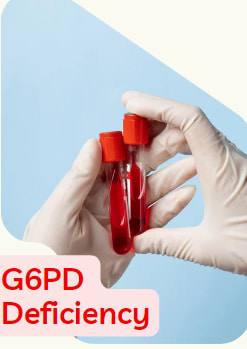Content :
◉ What is G6PD Deficiency?
A series of X linked illnesses known as glucose 6 phosphate dehydrogenase (G6PD) deficiency make red blood cells (RBCs) prone to hemolysis when subjected to oxidative stress (such as an infection, fava beans, or some drugs); they are characterized by acute hemolytic episodes and/or severe infant jaundice.

◉ Causes
One or more mutations for G6PD deficiency with exposure to certain agents like:
- Oxidative drugs [Primaquine, Sulfonamides, Dapsone, Nitrofurantoin, Ciprofloxacin, and Vitamin K]
- Chemicals [Naphthalene (found in balls), and 2,4,6 trinitrotoluene (found in explosives)]
- Infectious agents [Influenza A virus, Cytomegalovirus, and Hepatitis A and B viruses]
- Activities and clinical disorders [Diabetic keto acidosis, Myocardial infarction]
- Foods [Fava beans]
◉ Risk factors
- Sex: Males are affected more frequently than females
- Genetics: X linked recessive transmission.
- Variants of G6PD deficiency causing the most severe disease appear most often in Mediterranean populations.
- G6PD deficiency is found most commonly in geographic areas with the highest rates of malaria.
- Ethnicity/race:
- African descent: up to 39%
- Middle Eastern descent: 8% to 39%
- Southeast Asian descent: 8% to 22%
- Central and Southern Pacific Island descent: up to 7%
- Southern European descent: up to 3%
◉ Symptoms and Signs
Most G6PD deficiency sufferers go their entire lives without showing any symptoms, and they are completely unaware of their condition, that is, until they are exposed to a drug or chemical (like fava beans), which causes RBC hemolysis 24 to 72 hours after exposure.
- Jaundice and Pallor.
- Fatigue and weakness.
- Hematuria.
- Abdominal pain.
- Back pain.
- Concurrent infectious symptoms (eg, fever).
- Tachycardia.
◉ Complications
- Splenomegaly.
- Gallstones.
- Severe neonatal jaundice: Can lead to kernicterus, neurologic damage, and death if untreated.
- Hemolytic crisis: Brisk hemolysis and severe anemia can result in congestive heart failure.
- Renal failure: rare complication, even in presence of massive hemoglobinuria.
- Acute renal failure is more common with fava induced G6PD hemolysis.
- Acute tubular necrosis is a rare complication of G6PD related hemolysis and concomitant viral hepatitis.
- Death: Can be caused by neonatal jaundice or acute hemolytic anemia, if they are not effectively treated.
◉ Diagnosis and Screening
History and physical exam findings, such as severe anemia coexisting with hemoglobinuria following consumption of fava beans or a potentially hemolytic medication, strongly imply the diagnosis of G6PD deficiency.
After the acute hemolytic crisis has passed (2 3 weeks after the acute hemolytic event), additional testing for a particular disease is necessary if the history, physical examination, and blood cell count results are indicative of G6PD deficiency.
Diagnostic screening begins with quick semiquantitative testing. Quantitative evaluation of the overall percentage of G6PD enzymatic activity is done after the confirmatory test, which is the gold standard.
◉ Treatment
The objectives of treatment are to manage by ceasing the precipitating agent or treating the underlying clinical condition that is causing the oxidative stress, prevent hemolysis by educating patients and avoiding triggers, treat infant hyperbilirubinemia brought on by a G6PD deficiency as well as any necessary anemia.
Criteria for admission
- Acute hemolytic crisis
- Acute renal failure
- Infants with hyperbilirubinemia requiring admission for phototherapy and monitoring
Criteria for ICU admission
- Hemolytic anemia requiring transfusions
- Renal failure requiring dialysis
Recommendations for specialist referral
- Manage patients with diagnosed or suspected G6PD deficiency in consultation with hematologist
- Patients with diagnosed G6PD deficiency require consultation with genetic counselor
- Patients with renal failure require consultation with nephrologist
Stop using the precipitating agent or address the underlying medical issue that led to oxidative stress and subsequent hemolysis. The majority of the time, acute hemolysis brought on by G6PD deficiency is transient and does not need to be treated. Rarely do young toddlers and newborns need to get RBC transfusions in response to an acute hemolytic episode.
For hyperbilirubinemia, newborns could need phototherapy or an exchange transfusion. To prevent kernicterus and irreparable brain impairment, hyperbilirubinemia in the newborn period must be promptly managed.
Patients with nonspherocytic hemolytic anemia or chronic hemolysis may benefit from folic acid therapy.
◉ Conclusion
Despite the fact that G6PD is the most prevalent enzyme deficiency illness, the majority of patients with the diagnosis do not experience any symptoms, and those who do only experience brief symptoms with few or no problems. G6PD has the advantage of being largely avoidable.